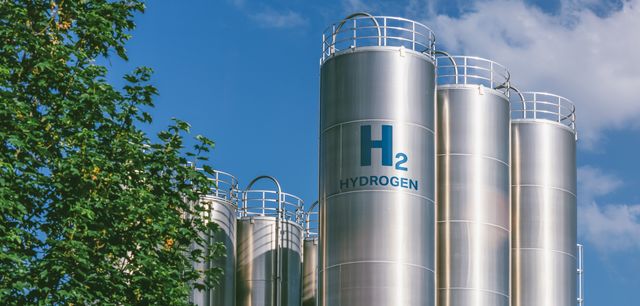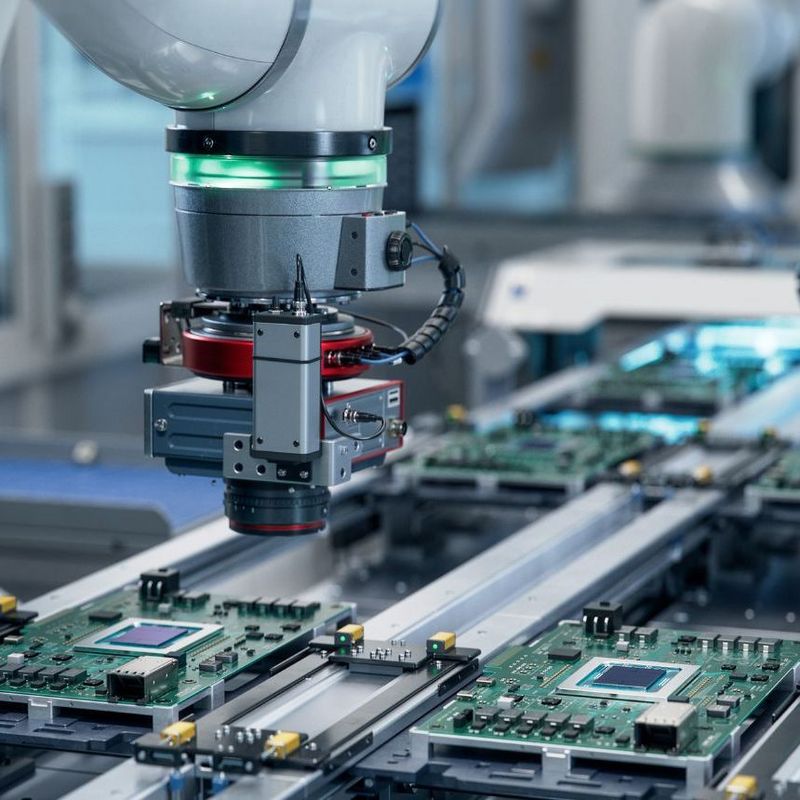26 June 2025
If the world is going to make its industry, energy supply and heavy goods transport more climate friendly, especially on water and in the air, then huge quantities of green hydrogen are going to be needed. But the development of the hydrogen economy is lagging far behind where it was planned and expected to be. What has gone wrong? And what needs to be changed to ensure that hydrogen production picks up speed?
Hopes were high in Kaisersesch in the German state of Rhineland-Palatinate: This municipality in the Eifel region was aiming to build a complete hydrogen infrastructure and thereby to blaze a trail in the energy transition. Green hydrogen was to be produced with renewable electricity and to be distributed, stored and used for refuelling and heating. But it was the single most important element of the Smartquart project that caused problems from the start: The electrolyser, which had been supplied by a French company, simply refused to work. E.ON finally terminated the contract in 2024, but procuring a new device would have been too time-consuming and costly. To supply the filling station and heating system anyway with the lightest element in the universe, the green hydrogen was brought in by tanker. Technically, there were no problems in these areas, so E.ON was able to draw a number of lessons from the pilot project.
The fact that it is being discontinued in any case is in no small measure down to the change in the economic conditions since the groundbreaking ceremony in 2022. “When the Ukraine crisis blew up, we really did have a lot of companies that were very interested in hydrogen. They were concerned with security of supply,” said Albert Jung, mayor of the municipality, to the broadcaster SWR. In the meantime, however, the price of natural gas has plunged once again to the extent that not a single company from the region wants to participate in the hydrogen project in Kaisersesch.
About Silvio Konrad
Silvio Konrad is Chief Executive Officer of the Energy & Resources business unit of the TÜV NORD GROUP and Chairman of the Board of Management of TÜV NORD EnSys.
And the Smartquart in the Eifel is by no means the only project to have been shelved or postponed in recent times because “the oil of tomorrow”, as the then Research Minister Anja Karliczek (CDU) called green hydrogen in 2020, has not yet become economically viable: Norwegian energy supplier Statkraft, which is also active in green hydrogen in Germany, announced in May that it would withdraw from the development of new projects. An electrolyser planned in Hanover was cancelled due to increased costs; a hydrogen pipeline between Denmark and Germany planned for 2028 is now not scheduled to go into operation until 2030.
But it’s not (all) doom and gloom
However, there is also progress to report: According to its operator, Europe’s highest capacity hydrogen filling station, at which up to three buses, lorries or fuel cell cars can fill up at the same time, was opened in Düsseldorf in May. The green hydrogen currently still has to be delivered, but the idea is to produce it on site from 2026.
Also in May, an electrolyser with a capacity of ten megawatts (MW), which is primarily intended to supply regional industry with climate-friendly hydrogen, went into test operation in Schwäbisch Gmünd. At the end of March, BASF commissioned a large electrolysis plant for its headquarters in Ludwigshafen. This plant can produce one ton of hydrogen, whose uses include the production of basic chemical materials, per hour and is thus expected to reduce the site’s CO2 emissions by 72,000 tons per year. A “milestone in the ramping up of the hydrogen economy in Rhineland-Palatinate, Germany and Europe” is how the state’s Prime Minister Alexander Schweitzer described the project, which is being funded by the federal and state governments to the tune of 124 million euros. And the plant, with its capacity of 54 MW, is indeed currently the largest of its kind in Europe. And yet, to achieve the electrolysis capacity of ten gigawatts by 2030 that was targeted by the former “traffic light” coalition, 185 more plants of this size would have to be built within the next few years.
Still a long way away from the ten-gigawatt target
According to a survey by the German Association of Energy and Water Industries (BDEW), 88 percent of the projects announced for 2030 are still in the concept and feasibility study phase. In only twelve percent of cases has the final financing decision been made or is construction already underway. Even so, their number has still tripled compared to 2023. As things stand, however, only a mere one percent of them is actually in operation.
Globally, there is even less progress to report, as a study by the Potsdam Institute for Climate Impact Research (PIK) has determined. According to the study, 97 percent of the projects that are scheduled for completion by 2030 are still in the concept and feasibility study phase. According to the authors of the study, this is due to increased costs, a lack of willingness to pay on the part of potential customers and regulatory uncertainties.
The price of hydrogen
In fact, according to BDEW, at almost seven euros per kilogramme green hydrogen is currently around twice as expensive as natural gas. By 2030, the costs could level off at an average of five euros. However, since it is not yet possible to predict how the prices for renewable electricity and electrolysers will develop, green hydrogen could equally plausibly get cheaper – or more expensive. The result is “palpable uncertainty”, which, according to the industry association, is having a negative impact on the willingness to invest.
“To compensate for additional costs and stimulate demand, it follows that we need targeted subsidies on an appropriate scale and market mechanisms like consistent CO2 pricing,” says Silvio Konrad, Chief Operating Officer of the Energy & Resources business unit at TÜV NORD. For the researchers at the Potsdam Institute for Climate Impact Research, binding quotas for the use of hydrogen in certain sectors are also an important lever. One example of this is an EU regulation according to which all aviation fuels will have to contain 1.2 percent of hydrogen-based synthetic fuels from 2030, rising to 35 percent by 2050.
© Adobe Stock"We need binding expansion targets for pipelines such as electrolysers so that the market ramp-up can succeed," says hydrogen expert Silvio Konrad.
© Adobe StockAmong other things, H2 buses have been able to top up their tanks at Europe's most powerful hydrogen refuelling station in Düsseldorf since May - from 2026 even with hydrogen produced on site.
How about expanding the colour spectrum?
Until the price of green hydrogen falls, however, blue hydrogen might also have a part to play as a pragmatic interim solution, according to the industry association BDEW. Like “grey hydrogen”, this is produced with natural gas, but the climate-damaging CO₂ is captured and bound up, for example, in concrete for road construction (CCU – Carbon Capture and Utilisation) or stored permanently in the ground (CCS – Carbon Capture and Storage).
Germany’s “traffic light” coalition government had also previously declared this blue hydrogen to be eligible for funding in principle. The new cabinet has likewise announced in its coalition agreement that it aims to use all colours of hydrogen to accelerate the ramp-up. To this end, it intends to introduce a law on CO2 storage and facilitate the approval of CCS and CCU plants. “What has been missing so far are regulations governing things like the specific form the promotion of blue hydrogen might take,” says energy expert Silvio Konrad from TÜV NORD. “However, hydrogen importers need their framework conditions for low-carbon hydrogen to be just as clear as domestic manufacturers in Germany.”
Certified climate friendliness
However, the use of blue hydrogen is not only controversial among environmental associations. There are fears of a prolongation of dependence on fossil fuels and the tying up of financial resources, which will then be lacking for the ramp-up of green hydrogen. Last but not least, there are doubts about its climate-friendliness, as the production of blue hydrogen does not capture all the CO2 and also releases methane, which is particularly harmful to the climate. “A uniform European certification system is therefore needed for all types of hydrogen that will demonstrate the environmental soundness, climate friendliness and social acceptability of its production and transport,” says Mr. Konrad. The experts from TÜV NORD are involved in various committees for the development of such a uniform standard, which will also be a decisive factor for Germany’s coalition government when it comes to the hydrogen ramp-up.
More commitment to the core network
A standard of this kind is important, not least because, even if the ten-gigawatt target is achieved, between 50 and 70 percent of Germany’s hydrogen demand will still have to be covered by imports going forward. To this end, the grand coalition under Angela Merkel and the “traffic light” coalition had forged various energy partnerships with countries with an abundance of wind and sun such as Egypt, Australia, Namibia and Canada. Within Germany, the “traffic light” coalition had previously scheduled a 9,040-kilometer pipeline network to connect the most important ports, electrolysers and customers by 2032.The new coalition under Friedrich Merz has also announced that it will expand this core network for hydrogen to include further routes, especially in the south and east of Germany. “But even though the first construction projects are underway, the planning and approval of the hydrogen core network are progressing slowly overall, delaying a lot of projects,” says Mr. Konrad. The “traffic light” government unveiled a hydrogen acceleration law back in 2024, but the collapse of the coalition meant that this did not make it to a parliamentary vote. “But this acceleration in planning and approval is urgently needed,” warns the expert. “We also need binding expansion targets for both pipelines and electrolysers to create the conditions for a successful commercial ramp-up.”
Hydrogen economy in the Sauerland
The experts of the TÜV NORD GROUP are involved in various hydrogen projects worldwide. For example, the experts from DMT ENERGY ENGINEERS are supervising the construction of a 100-megawatt electrolyser in Wilhelmshaven, advising the Egyptian Ministry of the Environment on the possibilities of exporting hydrogen to the EU and assessing the expansion of the port infrastructure for the city of Hamburg to allow hydrogen and its derivatives such as ammonia to be stored and transported from there. All of the Group’s hydrogen-related services and projects are pooled in the HydroHub. TÜV NORD is also actively involved in the HydroNet project in the Sauerland region. This project, which is being funded by the BMWK to the tune of 18 million euros, is intended to transform an entire region with its medium-sized industrial companies into a hydrogen economy over five years and thus to serve as a blueprint for the nationwide development of hydrogen infrastructure.






